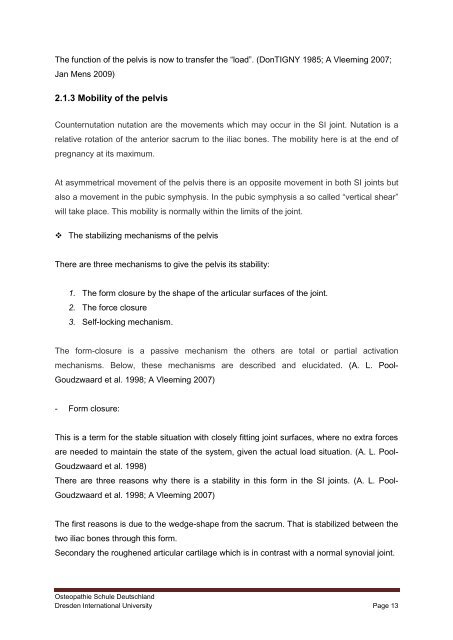Pelvic girdle pain and relevance of ASLR testing: A ... - Cindy Verheul
Pelvic girdle pain and relevance of ASLR testing: A ... - Cindy Verheul
Pelvic girdle pain and relevance of ASLR testing: A ... - Cindy Verheul
You also want an ePaper? Increase the reach of your titles
YUMPU automatically turns print PDFs into web optimized ePapers that Google loves.
The function <strong>of</strong> the pelvis is now to transfer the “load”. (DonTIGNY 1985; A Vleeming 2007;<br />
Jan Mens 2009)<br />
2.1.3 Mobility <strong>of</strong> the pelvis<br />
Counternutation nutation are the movements which may occur in the SI joint. Nutation is a<br />
relative rotation <strong>of</strong> the anterior sacrum to the iliac bones. The mobility here is at the end <strong>of</strong><br />
pregnancy at its maximum.<br />
At asymmetrical movement <strong>of</strong> the pelvis there is an opposite movement in both SI joints but<br />
also a movement in the pubic symphysis. In the pubic symphysis a so called “vertical shear”<br />
will take place. This mobility is normally within the limits <strong>of</strong> the joint.<br />
The stabilizing mechanisms <strong>of</strong> the pelvis<br />
There are three mechanisms to give the pelvis its stability:<br />
1. The form closure by the shape <strong>of</strong> the articular surfaces <strong>of</strong> the joint.<br />
2. The force closure<br />
3. Self-locking mechanism.<br />
The form-closure is a passive mechanism the others are total or partial activation<br />
mechanisms. Below, these mechanisms are described <strong>and</strong> elucidated. (A. L. Pool-<br />
Goudzwaard et al. 1998; A Vleeming 2007)<br />
- Form closure:<br />
This is a term for the stable situation with closely fitting joint surfaces, where no extra forces<br />
are needed to maintain the state <strong>of</strong> the system, given the actual load situation. (A. L. Pool-<br />
Goudzwaard et al. 1998)<br />
There are three reasons why there is a stability in this form in the SI joints. (A. L. Pool-<br />
Goudzwaard et al. 1998; A Vleeming 2007)<br />
The first reasons is due to the wedge-shape from the sacrum. That is stabilized between the<br />
two iliac bones through this form.<br />
Secondary the roughened articular cartilage which is in contrast with a normal synovial joint.<br />
Osteopathie Schule Deutschl<strong>and</strong><br />
Dresden International University Page 13


